
Today, we are going to talk about “personalized product recommendations” technology, give you an overview of the technology, and discuss key elements, supported by examples.
If you are dealing with the personalized product recommendations software for the first time, it may look complicated but in fact, software is purely based on consumer behaviors. The tool works by gathering data about your consumer and analyzing their browsing and buying behavior patterns.
For instance, imagine that somebody visits your online store for the first time, and suddenly spots products on your main page, which they were looking for earlier the same day. It means that visitor was already looking for that product configuration across Internet, and now he visits your Ecommerce website, where exact product category appears to him in your sales catalog. Same thing happens if somebody browsed through a specific category, like “Running shoes” in your store, the software will automatically generate a list of most popular running shoes models available in your store.
Displaying most relevant products to visitors of your store makes their shopping journey less time consuming, more personal and inspiring.
However, your main page is not the only place where personalization happens. The product story would be also shown to your visitors at category page, product detail page, shopping cart page, and even your 404-error page.
Product personalization is not only about your website. Everybody has seen email newsletters featuring a block of recommended products at least once. The same goes for advertising banners, showing us same items we left in the shopping cart while browsing in a different online store or lightning-fast web push notifications with a link to a personally tailored selection of recommended products.
Throughout the time, product personalization still takes a crucial part of marketing strategy of an online retailer. There are some cases where an online retailer does not use personalization, like a mono-product store or a small local store. Though, it is unlikely that bigger eCommerce will remain without any kind of personalization.
However, we have recognized a few major flaws in product personalization. For instance, when dealing with Big Data – personalization can become cure or trap for your business. Further, we are going to discuss in detail main issues.
To summarize:
- Product personalization is the key element of modern eCommerce.
- Product Personalization improves shopping experience.
- Product Personalization operates on multiple pages of your website.
- Product Personalization can be a part of marketing strategy.
Illogical Recommendation Logic
Big Data, personalization is driven by statistical data. In other words, if a significant number of consumers recently purchased laser printer and crib, along with coffee maker, personalization would recognize that as a buying behavior pattern and generate a suggestion of this two items along with coffee maker.
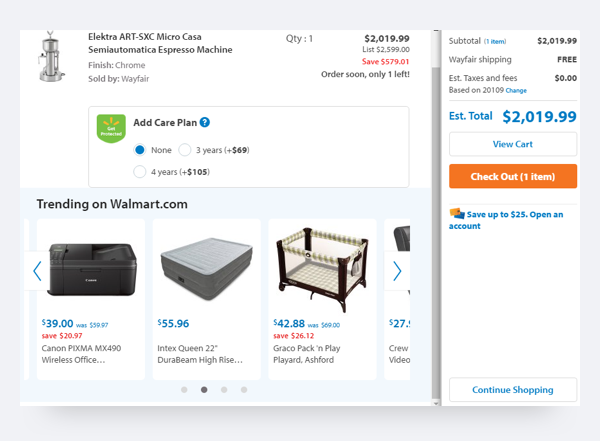
Example 1: Shows that personalization is driven by statistical data not by logic.
In this case, there is no viable logic, as recommendations do not fit with primary product. However, even if we see it as an issue, Big Data completely relays on statistics, and you won’t argue against it.
Universal does not mean precise
We have also recognized that Big Data is very precise to details. Earlier, we mentioned “running shoes” example, here comes the question: What else we can add to the product? As we know already a list of most popular running shoes models would appeal to retailer visitor. But, is it really enough of a recommendation to attract and involve visitor to make a purchase or to buy above his personal needs?
According to our research, the final purchase decision is affected by a very specific set of factors. Those factors vary depending on a segment. It is also recognized that Apparel & Accessories, Construction & Repair, Auto Products, Pet Products, Consumer Electronics or Home Appliances, Cosmetics & Beauty segments, are the most sensitive when it comes to the final purchase decision.
Therefore, for improving the effectiveness of personalization tool; first, you have to alter your marketing strategy, by taking into consideration key elements of your retail segment.
For example personalization strategy for Apparel and Accessories online retail, has to generate products suggestions divide by gender, also it is crucial for products to correspond in size. Imagine, if your store visitor was suggested a pair of desired running shoes, and finds out at the same time, they are completely sold out in his size and only available in two sizes smaller or bigger. Then you fail to satisfy your customer needs. This issue is also illustrated by the following example:

Example 2: While visitor of Forever 21 chose and added to the cart an XS hoodie, he can still see recommended items in the wrong size.
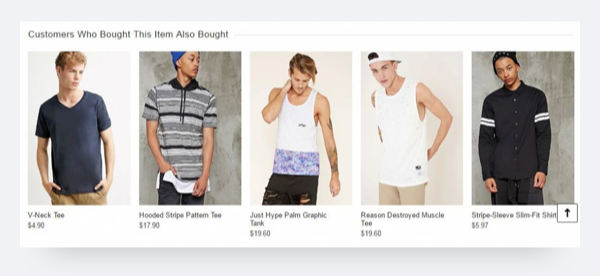
(Example 2.1)
Some items are in the wrong size, for instance, this white muscle tee is available only in XL:

(Example 2.2)
As we already said, Big Data takes actions relying on analytics, not logic.
Some businesses may overlook these issues, but on the other hand, there are retail segments, which don’t really have a choice, and they are forced to overcome personalization issues, otherwise, it can harm their customers.
- Recommendations for improving your marketing strategy while using Product personalization:
- Analyze your market segment and Include key elements to the marketing strategy of your business.
- Remember that Big Data relays purely on statistics, you have to bring your own logic to the marketing concept.
Pros and Cons of Big Data
We have recognized that in FMCG (Fast Moving Goods consumed every day) sector, Big Data can be really harmful to consumers. Especially, when dealing with goods that contain specific allergen; the majority of prospective buyers would not react to an allergen, but there is a percent of people, who are actually allergic to it. There is also a percent of people with the medical condition, limited to a strict diet. As a result, software generating not accurate product recommendations, where lactose intolerant customer will be suggested to buy milk, or diabetic deliberately buys a milk chocolate bar full of sugar.
A situation like that is also harmful to your business, as you have to pay money to take space in a block, and it would be taking by unrelated products, while relevant products are skipped.
| PROS | CONS |
| When dealing with Big Data there is a chance of generating not accurate recommendations. |
Increase sales. According to our research, the average increase of +24% in sales. |
| No viable logic | Highly accurate in statistical data |
| Big Data is not very precise in details | Can be used alongside with other marketing activities. |
What Is Progressive Personalization for Niche?
Progressive Personalization is a new technology that progressively and constantly adapts recommendations to each new visitor, every time he changes his behavior. The main goal is to keep recommendations highly relevant excluding non-fitting products from the block.
Progressive Personalization technology has been developed by REES46 Technologies and serves as the base of REES46 Marketing Suite — set of marketing automation & personalization tools for online retail.
Considering that each retail segment has a different set of key factors, which affect purchase decision, like pet type and breed for pet products or skin type. Therefor, REES46 developed an ultimate solution – Niche Solutions for every specific retail segment.
We are giving you a few tips and links already today, so that you can see main principles of Niche Solutions.
Progressive Personalization in Pet Products Niche
We would like to begin with basics, like a cat owner would not be recommended to buy food formulas for other animals. Still, to achieve great results you have to consider every aspect of the current segment.
| KEY CONSTRAINTS OF PET PRODUCT NICHE |
| PET TYPE |
| PET BREAD |
| PET AGE |
| BRAND PREFERENCES (customers, as well as their pets develop preference for a certain brand). |
| PURCHASE FREQUENCY (there are products bought more frequently, than other, e.g. food formulas). |
Those key factors allow Progressive Personalization technology to adjust recommendations in milliseconds.
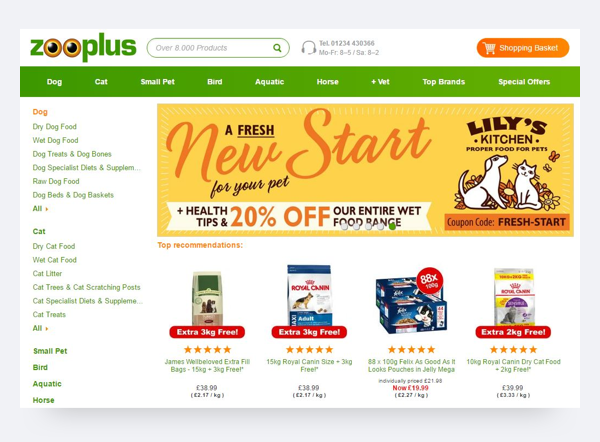
Example 3: Recommendations show mixed products: both for dogs and cats to a new visitor.
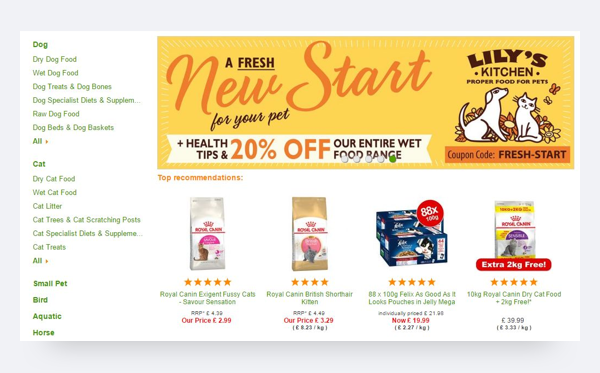
(Example 3.1)
*More details of Niche Solution for Pet Products stores are available for interested readers by this link.
How to use Progressive Personalization in Apparel and Accessories niche?
First of all, in apparel retailer, majority of customers are looking to buy items for themselves. Therefore, suggesting male products to female customer, irrelevant in this case.
| KEY CONSTRAINTS IN APPAREL AND ACCESSORIES NICHE |
| GENDER (male, female or unisex products) |
| SIZE (clothing, shoes) |
| BODY TYPE (fitting style) |
| INDIVIDUAL BRAND PREFERENCES |
If recommendation engine can calculate these parameters depending on visitor actions, it can exclude irrelevant products from recommendations. Consider the example below.
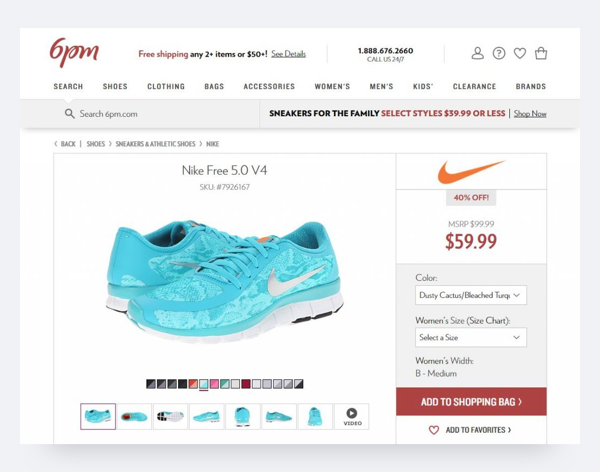
Example 4: Customer is browsing for female sneakers from Nike’s store.
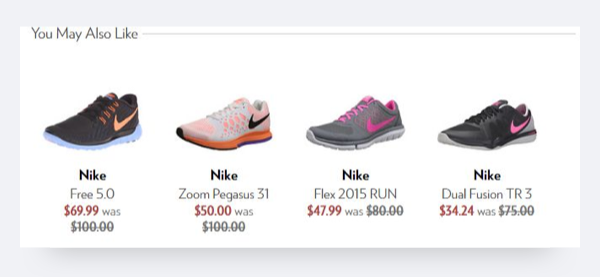
Example 4.1: Recommended products are sneakers for women, from the same brand.
Without progressive personalization, recommended items could include both male and female shoes from several brands: would significantly lower the chances of a successful purchase – when recommendations are actually taking to consideration by the customer.
*More details about Apparel & Accessories niche per are available by this link.
How to use Progressive Personalization in Cosmetics and Beauty niche?
We have noticed that beauty products are the trickiest retail segment. Because, purchase decision is affected by a multitude of different factors:
| KEY CONSTRAINTS IN APPAREL AND ACCESSORIES NICHE |
| GENDER (male, female or unisex products) |
| PRODUCT HYPOALLERGENIC PROPERTIES |
| SKIN TYPE (dry, normal, oily or mixed) |
| SKIN CONDITION (damages, diseases) |
| HAIR TYPE (dry, normal, oily, mixed) |
| HAIR CONDITION (brittle hair, split ends) |
| TYPE OF APPLICATION |
| PLACE OF APPLICATION (hands, feet, body, face) |
| BRAND PREFERENCES |
| PURCHASE FREQUENCY (almost all cosmetic products are bought on the regular basis) |
Relying on key constraints, only relevant products would appear in every recommendation block, to every visitor.
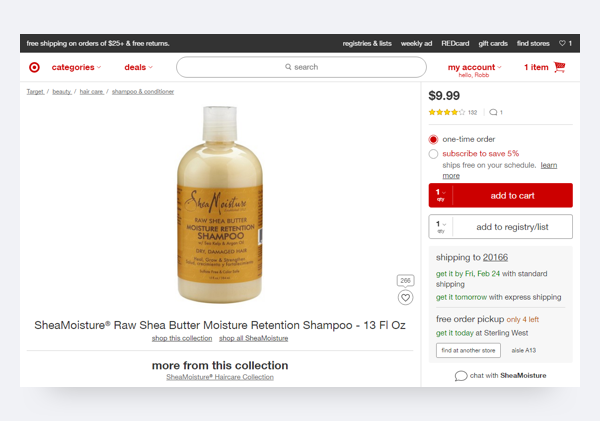
Example 5: Customer is browsing shampoo for oily hair type by Shea Moisture.
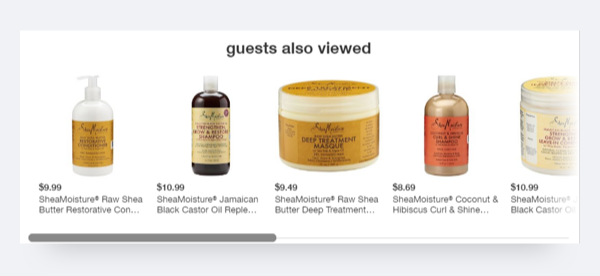
Example 5.1: Progressive Personalization technology makes sure the recommendation blocks show only relevant products — by the brand and by the hair type.
*More details about Cosmetics & Beauty niche personalization are available by this link.
Progressive Personalization technology makes sure that recommendation blocks generate only relevant products — by brand and hair type.
How to use Progressive Personalization in other Retail Segments?
To the date, REES46 Marketing Suite includes Progressive Personalization-driven Niche Solutions for the following 7 retail segments:
- Apparel.
- Home Appliances.
- Construction.
- FMCG/CPG.
- Cosmetics.
- Baby and Children.
- Pet Products.
Progressive Personalization technology delivers great results if used alongside with “classic” – Big Data. We analyzed that this combination leads to an average increase of +24% in sales, in specific retail niche.
A more detailed explanation of the underlying mechanics and logic of this tech in each segment in our eBook “Progressive Personalization in eCommerce”. Get your own free copy.